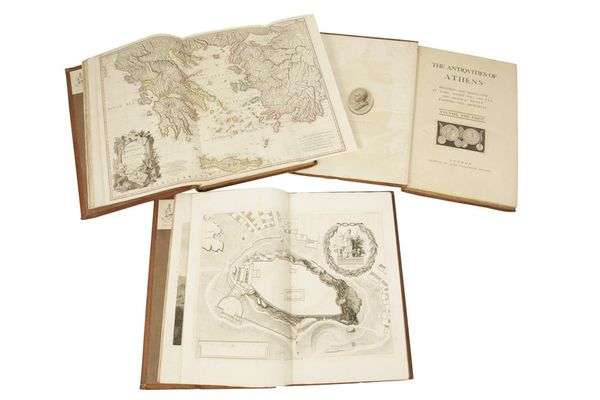Bidding ended. Lot has been sold.
STUART, JAMES & NICOLAS REVETT THE ANTIQUITIES OF ATHENS MEASURED AND DELINEATED BY JAMES STUART F R S AND F S A AND NICHOLAS REVETT, painters and architects. London: John Haberkorn for the Authors, 1762, 1782, & 1794. First edition, 3 vols. of 5, large folio, with 231 engraved plates, including folding and doublepage and a folding hand coloured map of Greece in vol. 3, contemporary calf, engraved head and tailpieces, Neo-Classical binding, with blind Greek-key pattern and gilt small egg and dart borders, spines decorated gilt in compartments with alternating bands of egg and dart and floral tools, a.e.g., by J. Bohn of London and with his small label at front, of vol. 1, outer joints a little rubbed, corners with a little wear, upper joint of vol. 3 splitting, lacking the final errata leaf in vol. 3, very occasional offsetting from the plates, otherwise a fine set with very good margins, with the armorial bookplate of William Phelps [3] Note: Volume 4 was published in 1816, printed by T. Bensley for J. Taylor; a supplementary fifth volume, "Antiquities of Athens and other places in Greece, Sicily etc." was published in 1830 in addition to the reprinting of the first 4 volumes by Priestley and Weale from 1825 to 1830. Lacks plate 29 from Vol. 2 chapter 1 which was never issued as explained on p. III of the Introduction. The portrait frontispiece of Stuart is in vol. 1, rather than vol. 2, and preliminary plates sometimes in vol. 3, in vol.1 The creation of the 'Greek Style' and its impact on British design in the late 18th century is largely due to Stuart's landmark publication Antiquities of Athens. Based on precise measured drawings done at the sites of the ancient ruins between 1751 and 1754, the work was the first accurate survey of ancient Greek architecture ever completed. The series of volumes allowed architects, sculptors and designers in Europe and America for the first time to use Neo-Classicism without having to go to Greece themselves and acted as a sourcebook for them for the next two centuries. It was still unfinished at the time of his death in 1788, with the final volume only appearing in 1816, when the Greek Revival it had fostered was starting to become the dominant force in British architecture.
Read more

